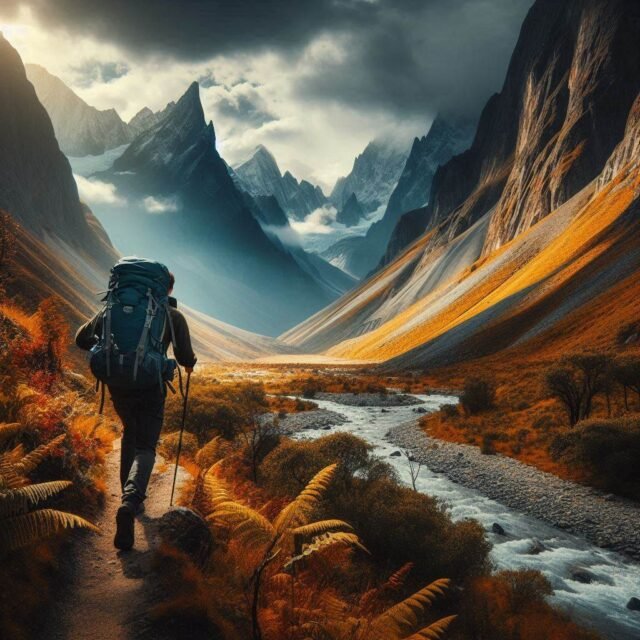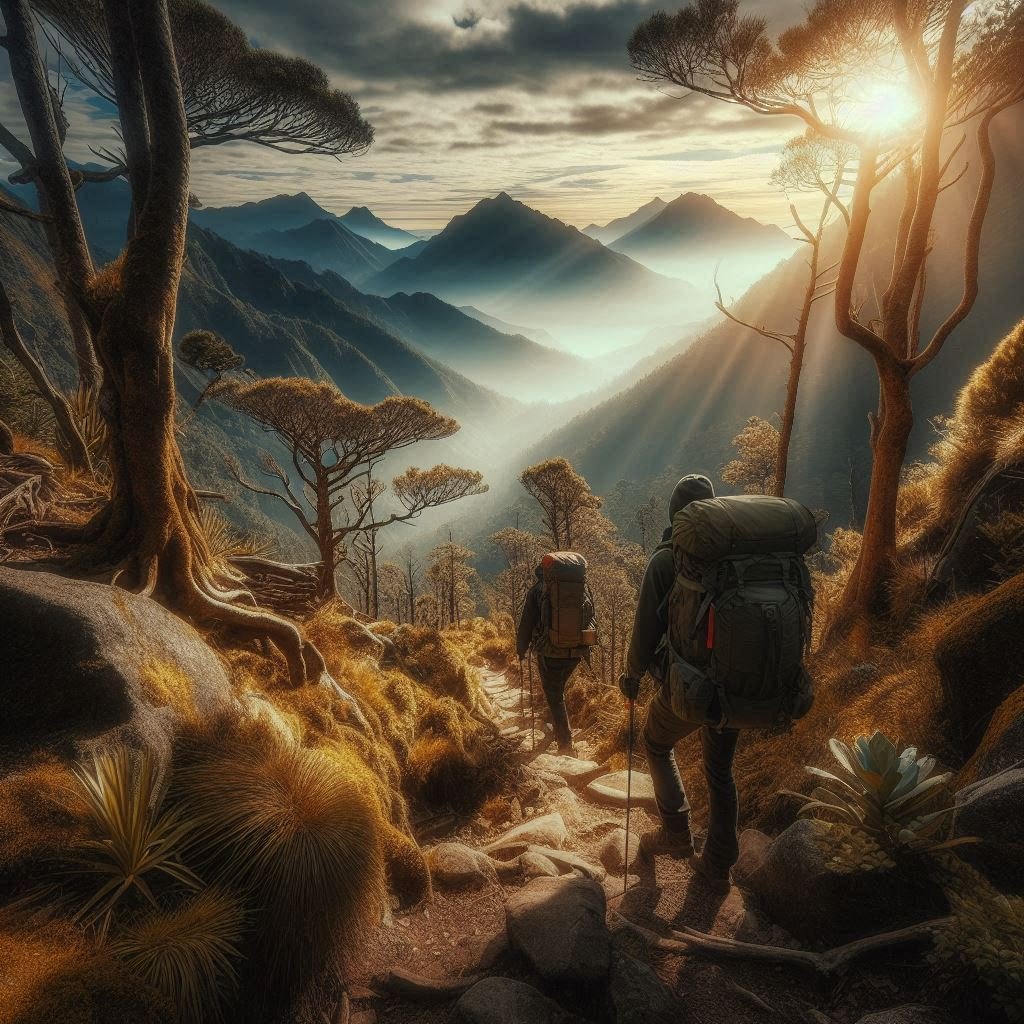Table of Contents
The lure of the great outdoors beckons, promising an escape from the hustle and bustle of everyday life. A day hike offers a chance to immerse yourself in nature, challenge your physical limits, and rejuvenate your mind, body, and soul.
However, before you embark on your trekking adventure, proper preparation is paramount to ensure not just a smooth and enjoyable hike, but also your safety and environmental responsibility.
This Outdoor Tech Lab guide dives into the essentials of day hiking, answering frequently asked questions we get, and providing a wealth of tips and resources to help you conquer the trails with confidence and respect for the wilderness.

The Essential Ten: Your Day Hiking Arsenal
1. Navigation: Getting lost can quickly turn a pleasant hike into a harrowing ordeal. Equip yourself with a detailed topographic map of the area, highlighting your planned route. A compass and the knowledge to use it effectively for triangulation are crucial, especially if GPS fails. Consider carrying a GPS device or a personal locator beacon (PLB) for emergencies.
2. Headlamp: Daylight fades faster than expected, especially under dense tree cover or in challenging terrain. Pack a reliable LED headlamp with spare batteries to avoid getting caught in the dark.
3. Sun Protection: The sun’s rays can be relentless on the trail, increasing the risk of sunburn, heat exhaustion, and skin damage. Protect yourself with a wide-brimmed hat, sunglasses with UV protection, and high-SPF sunscreen. We do love Supergoop! Consider investing in sun-protective clothing with a UPF (Ultraviolet Protection Factor) rating.
4. First-Aid Kit: Minor injuries are common on the trail, and being prepared can prevent them from escalating. A basic first-aid kit should include bandages, antiseptic wipes, blister treatment, pain medication, and any personal medications you require.
5. Knife or Multi-Tool: A sharp knife or multi-tool can be a lifesaver for cutting gear, preparing food, or making repairs. Choose one that is durable and versatile, with tools like pliers, scissors, and a bottle opener.
6. Fire Starter: Even on a day hike, the ability to build a fire can be essential for warmth, signaling for help, or boosting morale. Pack a fire starter tool, matches, a lighter, and tinder (dry leaves, dryer lint, etc.). Remember, fire restrictions may be in place, so check local regulations beforehand.
7. Emergency Shelter: Pack an emergency blanket or lightweight bivy sack to provide warmth and protection from the elements in case of unexpected weather or an unplanned overnight stay. We love the Life Tent! Bargin price and so lightweight.
8. Extra Food: Pack more high-calorie snacks and food than you think you’ll need. Trail mix, energy bars, and sandwiches are all great options to fuel your adventure and provide a boost of energy when you need it most.
9. Extra Water: Proper hydration is key to a successful and comfortable hike. Pack enough water for the duration of your hike, factoring in weather conditions, exertion level, and the availability of water sources along the way. Consider carrying a water filtration system if refilling opportunities are limited.
10. Extra Clothing: Weather on the trail can be unpredictable, and being prepared for changing conditions is essential. Pack an extra layer of clothing, such as a rain jacket, fleece, or hat, to adapt to varying temperatures and precipitation.
Planning Your Perfect Day Hiking Adventure
- Choose Your Trail: Research trails in your area that match your fitness level, time constraints, and desired difficulty. Consider factors such as distance, elevation gain, terrain, and scenery. Utilize resources like the National Park Service website, hiking clubs, and guidebooks to find the perfect trail.
- Check the Weather: Monitor the weather forecast closely in the days leading up to your hike and on the day itself. Be prepared to adjust your plans or reschedule if severe weather is expected.
- Pack Appropriately: Based on the trail conditions, weather, and duration of your hike, pack the essentials listed above, as well as any additional trekking gear or supplies you may need, such as trekking poles, insect repellent, or a lightweight camp stove.
- Inform Others: Always let someone know your hiking plans, including your route, expected return time, and any other relevant details. This can be crucial in case of an emergency.
- Fuel Up: Eat a hearty and nutritious meal before your hike to provide the energy you’ll need for the trek. Pack snacks and meals that are easy to carry and consume on the trail, such as energy bars, trail mix, and sandwiches.
- Stay Hydrated: Proper hydration is crucial for a successful day hike. Drink plenty of water before, during, and after your hike. If you’re hiking in hot or humid conditions, consider bringing electrolyte-replenishing drinks or tablets.
- Pace Yourself: Start your day hike at a comfortable pace and adjust as needed based on the terrain and your fitness level. Take breaks as necessary to rest, hydrate, and refuel.
- Leave No Trace: Respect the environment by practicing the principles of Leave No Trace. Pack out all trash, including food scraps, and stay on designated trails to minimize erosion and environmental impact. Be mindful of wildlife and avoid disturbing their habitat.
- Be Flexible: Nature can be unpredictable, so be prepared to adjust your plans if necessary. If conditions become unsafe or you encounter unexpected challenges, turn back or seek an alternate route.

Gear Up for Adventure: Top Amazon Picks for Hikers
Ready to hit the trails with your newfound knowledge? Check out these Amazon best-sellers to complete your day hiking arsenal:
-
Navigation: The National Geographic Trails Illustrated Map Series [National Geographic Trails Maps] offers detailed, all-weather maps for popular hiking destinations across the US.
-
Hydration: The Hydro Flask Standard Mouth Water Bottle [Hydro Flask Standard Mouth Water Bottle] keeps your water icy cold all day long, perfect for hot weather hikes or running from the squatch.
-
Sun Protection: The Salomon Speedcross 5 Hiking Shoe [Salomon Speedcross 5] provides excellent traction and comfort on a variety of terrains, while the Columbia Bora Bora Booney Hat [Columbia Booney Hat] offers superior sun protection for your head and neck.
-
First-Aid: The Adventure Medical Kits Mountain Series Backpacker Medical Kit [Adventure Medical Kits Mountain Series Backpacker Kit] is a comprehensive kit designed for treating minor injuries on the trail.
These are just a few suggestions to get you started. With a little research, you’ll find the perfect gear to match your day hiking needs and budget.
Remember, investing in quality equipment can make all the difference in your hiking adventure experience!
Frequently Asked Day Hiking Questions (FAQs):
– What should I wear day hiking? Wear comfortable, moisture-wicking clothing that allows for freedom of movement. Layers are essential to adapt to changing temperatures. Sturdy hiking boots with good ankle support and traction are a must. Consider investing in hiking socks designed to wick away moisture and prevent blisters.
– How much water should I bring? A general rule of thumb is to pack half a liter of water for every hour of hiking. However, this can vary based on factors such as temperature, humidity, exertion level, and personal hydration needs. In hot weather or strenuous hikes, plan to carry more water.
– What should I do if I encounter wildlife? Remain calm and avoid sudden movements or loud noises that could startle the animal. Give wildlife a wide berth and observe them from a safe distance. Never approach, feed, or attempt to touch wild animals.
– What if I get lost? Stay calm and stop moving. Retrace your steps if possible, or find a safe and visible location to wait for help. Use your navigation tools, such as a map and compass, to try to determine your location. If you have a personal locator beacon or satellite communication device, activate it to signal for assistance.
– What are some good resources for planning a hike? The National Park Service website offers information on trails across the country, as well as safety tips and regulations. The American Hiking Society provides resources, trail recommendations, and educational materials. Local hiking clubs and outdoor retailers can also be valuable resources for planning and preparing for your day hiking adventure.
Hitting the Trail with Confidence and Respect:
With the 10 Essentials packed, your planning complete, and these FAQs addressed, you’re well on your way to a fantastic hike. Remember, day hiking is as much about the journey as the destination.
Savor the fresh air, the scenic views, and the feeling of accomplishment that comes with conquering a trail.
Respect the wilderness and leave no trace, ensuring that future generations can enjoy the beauty of nature as you have.
Happy and Responsible Hiking and Trekking!
Further Resources for Day Hiking:
- Amazon Day Hiking Deals Today https://amzn.to/3wz8tDF
- Leave No Trace Center for Outdoor Ethics https://lnt.org/
- American Hiking Society https://americanhiking.org/
- The National Park Service https://www.nps.gov/index.htm

Introducing JC – The Outdoor Gear Enthusiast and Tester behind Outdoor Tech Lab:
Dive into the exciting world of outdoor gear technology with JC, the founder and driving force behind Outdoor Tech Lab.
With a passion for backpacking, nature and a knack for outdoors gadgets, JC has embarked on a mission to help others explore the outdoors in smarter, safer, and more enjoyable ways.
Join us on the adventure as we explore the ever-evolving landscape of outdoor gear & technology.
Through insightful reviews, practical tips, testing and engaging stories, Outdoor Tech Lab is your one-stop shop for navigating the wild world of outdoor gadgets and gear in 2024 and beyond.




Leave a Reply